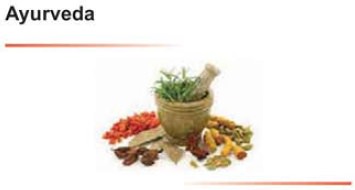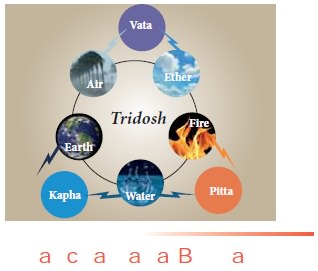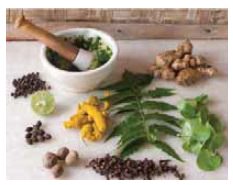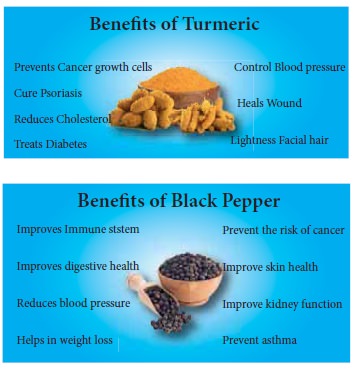Ayurveda: Origin, Perspective, Causes, Diagnosis, Treatment - Types of Alternative Medicine | 11th Nursing : Chapter 12 : Alternative Medicine and Practices in Nursing
Chapter: 11th Nursing : Chapter 12 : Alternative Medicine and Practices in Nursing
Types of Alternative Medicine
Types of Alternative Medicine
Ayurveda

Ayurveda literally
means “The Science of Life” and it
represents the oldest complex medical system about healthy lifestyle principle.
[Ayur-life, veda- knowledge (or) science]
Ayurveda aims at
making a happy, healthy and peaceful society. The two most important aims of
Ayurveda are:
·
To maintain the health of healthy people.
·
To cure the diseases of sick people.
The Origin of Ayurvedic Medicine
Auyveda originated in
the vedic civilization of India about 4,000 years ago. The origin of its
teachings dates back to the ancient Indian scriptures [Vedas]
Atreys was the first great physician and teacher of ayurvedha. “SushruthaSamhita” is written by the
great surgeon sushrutha who says “The physician, the patient, the drug and
nurses are four feet of the medicine upon which the cure depends.
The great physician
Charaka was written the charakasamhita in which he deals with ayurvedic
surgery.
Ayurveda is regarded
as the mother of all medical system.
·
In India we had the ayurvedic system of medicine which can be
traced of about 3000 B.C. Ayurveda stressed on hygiene, prevention of sickness,
Inoculation against small pox, Lavatories, good ventilation, construction of
hospitals, cultivation of medicinal plants.
Ayurvedic Perspective
·
Ayurveda represents a holistic and simple form of healing
approach
·
Ayurvedic practice above all appeals to conscious prevention,
healthy life style.
·
Following a programme of positive change to include proper diet
a regular herb usage it is possible to remove various health problems.

The central concept of
Ayurvedic medicine is the theory that health exist when there is a balance
between three fundamental bodily humors (or) doshas called [Vatha, Pitta,
Kapha].

The Body Matrix
Life in ayurveda is
conceived as the union of body senses, mind and soul. Thus the total body matrix
comprises of the humours, the tissue and waste product of the body.
Causes of Disease
·
It represent the balance between three biological principle
[Vata, Pitta, Kapha], bodily tissues, their function, sensory organs, the mind
and psychic consciousness.
·
Imbalance [vata, pitta, kapha] can be caused by number of
factors, including stress, lifestyle and improper diet.
·
Imbalance of the body and bias from its natural balance results
in different kinds of ailments.
Diagnosis in Ayurveda
There are three main methods
mentioned in Ayurveda for diagnosing the Dosha imbalance and disease process in
a person. They are –
1.
Darsana Pareeksha – By observing the patient’s physical signs
and symptoms,
Example – colour of skin, hair, eyes,
behavior, body condition etc.
2.
Prasna Preeksha – By asking minute questions regarding the
imbalance of each Doshas.
3.
Sparsana Pareeksha – By touching the patient. The pulse
diagnosis, palpation, percussion and auscultation are included in this method.
4.
Nadi Pareeksha (Pulse diagnosis) is a very important tool for
diagnosis. The physician feels the radial artery pulsations on the wrist of the
patient and through his experience he can get a clear picture of the milieu
interior.

Treatment
The treatment in
Ayurveda can be classified broadly into two:-
1.
Shamana Chikitsa (Alleviating Therapy)
2.
Sodhana Chikitsa (Purification Therapy)
Samana Chikitsa
This is specially done
after the sodhana therapy and in less vitiation. Herbal medicines are used
internally and externally to correct the derangement of functions of Doshas,
Dhatus, Malas and Agni and also to increase the Immunity. The restoration of
normality is brought about without any elimination.
Sodhana Chikitsa
The main aim of this
treatment is to eliminate the internal causative factors of the disease. Large
quantities of toxic bi-products are formed in the body as a result of
continuous metabolic process. All though most of these toxins are eliminated
naturally by the body’s excretory system, some may get deposited in the various
tissues of the body, which ensures the vitiation of Doshas, Dhatus etc. and
then the normal functioning of the system is impaired. Similarly disease
causing toxins accumulate in the body as a result of various factors like wrong
body habits, wrong food habits, incompatible combination of food items,
suppression of the body urges, emotional imbalance etc. Panchakarma therapeutic
procedures are used to facilitate the elimination of such harmful factors.
Panchakarma is the
cornerstone to Ayurvedic management of disease. Pancha Karma is the process,
which gets to the root cause of the problem and re-establishes the essential
balance of ‘Tridosha’ (three doshas: Vata, Pitta and Kapha) in body.
Panchakarma is a
Sanskrit word that means “five actions” or “five treatments”. This science of
purifying the body is an ancient branch of Ayurveda.
Panchakarma is
designed to reduce symptoms and restore harmony and body balance. To achieve
this an Ayurvedic Practitioner might rely on:-
Blood – Purification
Massage – Medical oils, herbs.
Enemas (or) Laxativs – Cleanse your body of undigested foods.

Physician – should use
his knowledge with humility, wisdom, service of humanity.
Medicaments – Food and
drugs.
Nursing – Must know
the skills of their art affectionate, sympathetic, intelligent, heat clean and
Resourceful.
“ONLY THE SILENCE OF THE HEART CAN CURE THE ILLNESS OF THE
MIND”
Patient – Co-operative
and obedient to follow instruction of the physician.
·
Regulation of diet as therapy has great importance.
·
An individual’s mental and spiritual development is influenced
by proper treatment.
·
Ayurveda stresses the use of plant based medicine and treatment
with some animal products and added minerals.
Related Topics